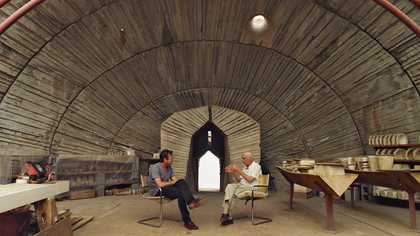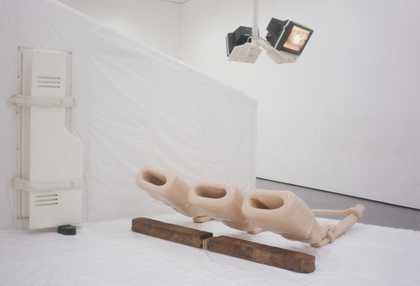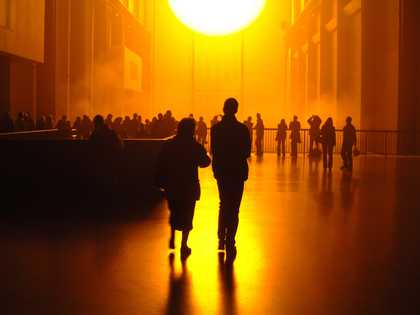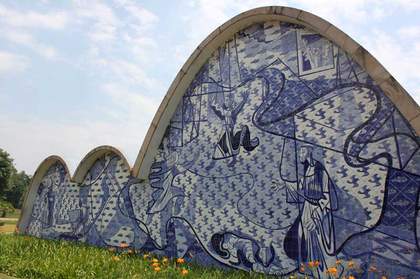
Oscar Niemeyer’s Chapel of St Francis of Assisi tiled front
St Francis himself beckons the traveller from the blue and white tiled mural on the building’s roadside wall, gesticulating amid a swirl of birds, fishes and beasts. An abstract mosaic dances across the side of the building like a hymn of praise. A concrete latticework belltower stands sentinel, widening as it rises. I wanted to hear the bells peal out across the water.
Completed in 1943, it was commissioned along with a casino, a yacht club and a ballroom by the Mayor, Juscelino Kubitschek, who obviously knew a thing or two about what his electorate wanted. So much so that he went on to become the President who created Brasilia, and in the process gave Niemeyer his defining commission: to shape the new capital’s architecture.
It’s extraordinary to think this chapel might have been demolished by those who thought it unfit for worship. The controversy meant it wasn’t consecrated until 1959. Alone for a few minutes in its simple wooden clad interior, with the light flooding in from the lake, I felt blessed by Neimeyer’s vision.
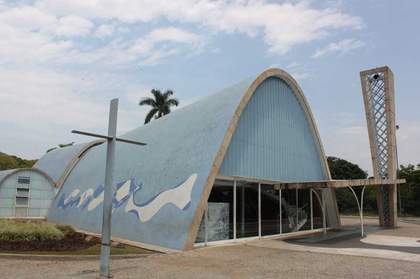
Oscar Niemeyer’s Chapel of St Francis of Assisi Roof
The architect is reported to have been inspired by the French poet Paul Claudel’s statement that: ‘A church is God’s hangar on earth’, but the Archbishop of Belo Horizonte described it instead as ‘the devil’s bomb shelter’. The building survived its critics, as did its architect, who is reputedly still working at the age of 104.
It was good fortune to see Niemeyer’s chapel on our journey to Inhotim, and made me wonder about the enduring impact that powerful patrons, architects and artists can have on our ordinary lives. Remarkable projects come from remarkable people and Inhotim is the creation of Bernardo Paz, a mining magnate who has lavishly installed his contemporary art collection across several hillsides in Minas Gerais, an estate of some 5000 acres. Paz has commissioned many architects (including Niemeyer and the landscape architect Burle Marx who designed the landscape around his Belo Horizonte buildings), to make pavilions specially designed for individual artists, and others that house several artists’ works, all cushioned within the lush vegetation of a botanic garden.

Mines seen from the flight into Belo Horizonte
Blue and white tiles recur in the pavilion dedicated to the Brazilian artist Adriana Varejão, who was married to Paz at the time it was built. Paz commissioned it, so the story goes, as a present to his wife. Quite some present. The concrete bunker is cantilevered off a grassy bowl, perched like a contemporary Taj Mahal above a pool of improbably blue water.
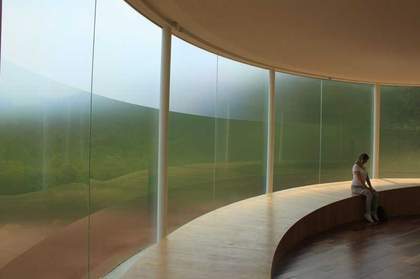
Doug Aitken’s Sonic Pavilion
Doug Aitken’s Sonic Pavilion uses high-sensitivity microphones plunged down a 633-foot bore hole to yield an unnerving live sound track from the bowels of the earth. As if to further destabilize your perceptual certainties, the surrounding glass wall gradually and inexplicably becomes foggy and blurred, the surrounding landscape seemingly vaporized. Was it something I did?
One of the most successful commissions is Olafur Eliason’s Viewing Machine which invites us to survey the landscape around Inhotim through a massive kaleidoscope. Gripping the handle, you can point the machine to the mountains or forests or earthworks on the horizon, to make a spectacle of the scene, as it splinters into a dazzling pattern. Is this optical thrill the sensation patrons and architects and artists must feel when they make their mark on the earth.

Olafur Eliason’s Viewing Machine
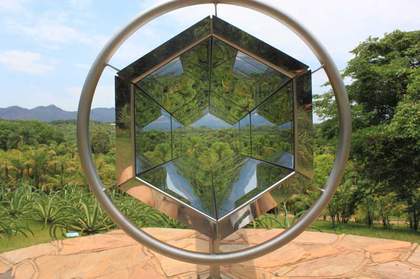
Olafur Eliason’s Viewing Machine, looking through the lens
Inhotim is umbilically linked to the mines that clear the landscape to extract the mineral wealth from the earth, as Matthew Barney’s commission bears witness to. And in a sense, Inhotim reinvests this landscape with man-made and natural wonders.
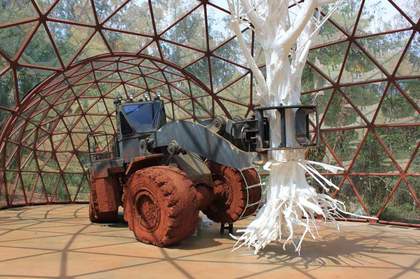
Matthew Barney's commission
If you like contemporary art, architecture and gardens - and I do - this place is a tropical Nirvana. It also has great food. And not one but two swimming pools that anyone can use if you know to bring your togs. (The prospect of the three-hour drive to the airport sitting in wet bra and knickers was the only thing that stopped me stripping off on a hot November day).
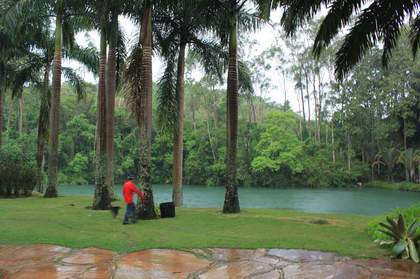
Landscape at Inhotim
What is most remarkable at Inhotim today is the strong sense of social purpose that has grown as the project has developed from being a wealthy homestead to one of the art wonders of the world. What began life as a personal art collection installed on a glamorous scale, has become the town of Brumadinho’s second largest employer (after mining), and it continues to drive economic and social development locally. Inhotim wasn’t dreamt up or demanded by government but by an individual with the means to think big and with the imagination to see beyond private pleasures to a collective purpose.
Government now supports its public programmes, and local communities use the site in collective and individual ways – neighborhood bands assemble and perform there, brides bring their grooms to be photographed on the bridge. School groups can spend a day at this outdoor museum – an experience as extraordinary for them as it is for every visitor to this place.
Inhotim is a partner with Tate in the turbinegeneration online programme, so its local communities now share their own artwork and ideas with young people anywhere in the world. What are the chances that one of those young people from Brumadinho will one day take inspiration from Niemeyer and Paz to create art or architecture that will make future generations stop and stare? I’d bet on it.
As Tate’s Head of National and International Initiatives, Judith Nesbitt is responsible for collaborative projects and partnerships.

